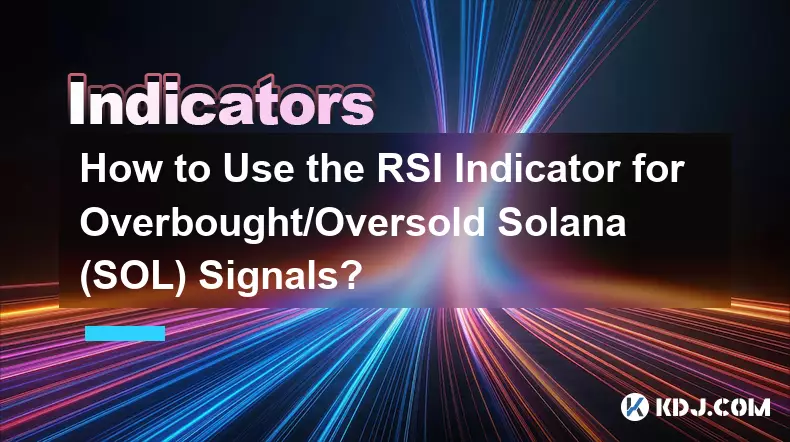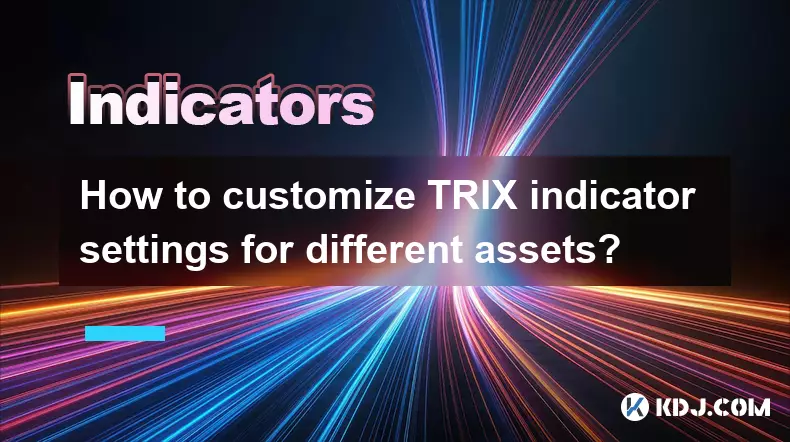-
 bitcoin
bitcoin $102877.190955 USD
1.88% -
 ethereum
ethereum $3430.435064 USD
4.52% -
 tether
tether $0.999264 USD
-0.05% -
 xrp
xrp $2.307310 USD
4.49% -
 bnb
bnb $987.740692 USD
3.82% -
 solana
solana $161.947760 USD
3.97% -
 usd-coin
usd-coin $0.999712 USD
-0.05% -
 tron
tron $0.292810 USD
2.93% -
 dogecoin
dogecoin $0.179738 USD
10.70% -
 cardano
cardano $0.580716 USD
8.75% -
 hyperliquid
hyperliquid $42.463448 USD
8.40% -
 chainlink
chainlink $15.763437 USD
7.05% -
 zcash
zcash $649.595636 USD
17.21% -
 bitcoin-cash
bitcoin-cash $511.610261 USD
7.19% -
 stellar
stellar $0.292537 USD
7.91%
How to Use the RSI Indicator for Overbought/Oversold Solana (SOL) Signals?
The RSI indicator helps crypto traders identify overbought (above 70) or oversold (below 30) conditions in volatile assets like Solana, signaling potential reversals when combined with price action and volume analysis.
Oct 31, 2025 at 09:00 pm

Understanding the RSI Indicator in Crypto Trading
1. The Relative Strength Index (RSI) is a momentum oscillator widely used in cryptocurrency trading to measure the speed and change of price movements. It operates on a scale from 0 to 100, helping traders identify potential reversal points based on overbought or oversold conditions. For assets like Solana (SOL), which exhibit high volatility, RSI provides timely signals that can guide entry and exit decisions.
2. Traditionally, an RSI value above 70 indicates that an asset may be overbought, suggesting a possible pullback or correction. Conversely, an RSI below 30 implies the asset could be oversold, hinting at a potential upward rebound. These thresholds are particularly relevant for Solana due to its rapid price swings within short timeframes.
3. The standard RSI period is set at 14 candles, but traders often adjust this setting depending on their strategy. Shorter periods increase sensitivity and generate more signals, while longer periods smooth out noise and reduce false triggers. In fast-moving markets such as SOL/USDT, using a 9-period RSI may capture turning points earlier than the default setting.
4. Divergence between RSI and price action serves as a powerful signal. If Solana’s price reaches a new high but the RSI fails to surpass its previous peak, it forms a bearish divergence—indicating weakening bullish momentum. Similarly, when the price hits a lower low but RSI records a higher low, it reflects hidden strength and possible upside ahead.
5. RSI should not be used in isolation. Combining it with support/resistance levels, volume analysis, or moving averages enhances its reliability. For instance, an oversold RSI reading near a key horizontal support level increases the probability of a bounce in Solana’s price.
Interpreting Overbought Signals in Solana
1. When Solana's RSI climbs above 70, it suggests strong buying pressure has pushed the asset into overbought territory. This does not necessarily mean an immediate sell-off will occur, but rather that upward momentum might be exhausting itself.
2. A sustained RSI above 70 during a strong uptrend can indicate persistent demand rather than an imminent reversal. In such cases, traders watch for bearish confirmation—like a pinbar candlestick pattern or declining volume—to validate a potential top.
3. An effective technique involves waiting for the RSI to cross back below 70 after exceeding it. This crossover acts as a trigger for short entries or profit-taking, especially if accompanied by resistance rejection on the chart.
4. Extended overbought conditions are common in altcoin rallies. During bull phases, Solana may remain above RSI 70 for several days without correcting sharply. Traders must differentiate between healthy parabolic moves and unsustainable pumps showing signs of capitulation.
5. Monitoring higher timeframes like the 4-hour or daily chart helps avoid premature exits. An overbought signal on the 15-minute chart may simply represent a minor retracement within a larger bullish structure.
Identifying Oversold Conditions in SOL
1. When Solana’s RSI drops below 30, it signals that selling pressure has become intense, potentially driving the price too low too quickly. Such levels often precede short-term rebounds or trend reversals.
2. In downtrends, repeated trips below RSI 30 do not guarantee immediate recovery. Each successive low may reinforce bearish sentiment until institutional accumulation or macro catalysts shift market dynamics.
3. A bullish reversal becomes more credible when RSI emerges from below 30 while price holds above a known support zone. This confluence increases confidence in long setups, particularly if candlestick patterns like hammers or engulfing bars appear.
4. During flash crashes or liquidation cascades, Solana’s RSI can plunge deep into oversold zones—sometimes even touching 10 or lower. These extreme readings often mark capitulation events where panic selling exhausts bears and sets up sharp recoveries.
5. Scalpers use these deep oversold bounces for quick profits, entering long positions once RSI breaks back above 30 with rising volume. Position traders wait for additional confirmation, such as a break of a descending trendline or a close above the 20-period EMA.
Frequently Asked Questions
What RSI settings work best for day trading Solana?A 9-period RSI on 15-minute or 1-hour charts offers responsive signals suitable for intraday strategies. Many traders combine this with Bollinger Bands to filter false breakouts.
Can RSI predict exact tops and bottoms in SOL’s price?No indicator can pinpoint exact turning points consistently. RSI highlights areas of potential exhaustion but requires price action confirmation. Blindly trading every overbought or oversold signal leads to losses in trending markets.
How does volume affect RSI interpretation for Solana?High volume during RSI crossovers strengthens the validity of the signal. For example, an RSI drop below 30 on low volume may reflect sideways consolidation, whereas the same move on surging volume suggests genuine selling pressure.
Is RSI equally effective across all market cycles for SOL?RSI performs differently in ranging versus trending environments. In choppy markets, it excels at identifying reversals. In strong trends, it frequently gives premature contrarian signals, requiring adaptation through trend filters or dynamic thresholds.
Disclaimer:info@kdj.com
The information provided is not trading advice. kdj.com does not assume any responsibility for any investments made based on the information provided in this article. Cryptocurrencies are highly volatile and it is highly recommended that you invest with caution after thorough research!
If you believe that the content used on this website infringes your copyright, please contact us immediately (info@kdj.com) and we will delete it promptly.
- BlockDAG, Avalanche, Dogecoin: Crypto's Leading Trio in 2025
- 2025-11-07 22:05:01
- Layer 2 Coins: Will There Be a Potential Explosion by 2026?
- 2025-11-07 16:50:02
- Filecoin, ICP, and the AI Infrastructure Renaissance: Is History Repeating?
- 2025-11-07 16:50:02
- Bitcoin's Wild Ride: Surges, Zeros, and the Search for Stability
- 2025-11-07 17:05:01
- XRP, Bitcoin, and the Rally: What's the Deal, New York?
- 2025-11-07 17:25:01
- Filecoin, DePIN, and a Technical Breakout: What's the Buzz?
- 2025-11-07 17:05:01
Related knowledge

How do professional traders use the TRIX indicator?
Nov 06,2025 at 04:40pm
Understanding the TRIX Indicator in Crypto TradingThe TRIX (Triple Exponential Average) indicator is a momentum oscillator used by professional trader...

Can I use the TRIX indicator on my mobile trading app?
Nov 07,2025 at 07:40pm
The TRIX indicator, a momentum oscillator designed to filter out short-term fluctuations and highlight long-term trends, has become increasingly popul...

How to code a simple TRIX indicator script in Pine Script?
Nov 07,2025 at 06:20am
How to Code a Simple TRIX Indicator in Pine Script The TRIX (Triple Exponential Moving Average) indicator is widely used in cryptocurrency trading to ...

How to trade TRIX indicator signals on the 1-hour chart?
Nov 07,2025 at 05:39am
Bitcoin's Role in Decentralized Finance1. Bitcoin remains the cornerstone of decentralized finance, serving as a benchmark for value and security acro...

Can the TRIX indicator be used for long-term investing?
Nov 06,2025 at 02:19pm
Understanding the TRIX Indicator in Cryptocurrency Markets1. The TRIX (Triple Exponential Average) indicator is a momentum oscillator designed to filt...

How to customize TRIX indicator settings for different assets?
Nov 06,2025 at 03:39pm
Understanding the TRIX Indicator in Cryptocurrency Trading1. The TRIX (Triple Exponential Average) indicator is a momentum oscillator designed to filt...

How do professional traders use the TRIX indicator?
Nov 06,2025 at 04:40pm
Understanding the TRIX Indicator in Crypto TradingThe TRIX (Triple Exponential Average) indicator is a momentum oscillator used by professional trader...

Can I use the TRIX indicator on my mobile trading app?
Nov 07,2025 at 07:40pm
The TRIX indicator, a momentum oscillator designed to filter out short-term fluctuations and highlight long-term trends, has become increasingly popul...

How to code a simple TRIX indicator script in Pine Script?
Nov 07,2025 at 06:20am
How to Code a Simple TRIX Indicator in Pine Script The TRIX (Triple Exponential Moving Average) indicator is widely used in cryptocurrency trading to ...

How to trade TRIX indicator signals on the 1-hour chart?
Nov 07,2025 at 05:39am
Bitcoin's Role in Decentralized Finance1. Bitcoin remains the cornerstone of decentralized finance, serving as a benchmark for value and security acro...

Can the TRIX indicator be used for long-term investing?
Nov 06,2025 at 02:19pm
Understanding the TRIX Indicator in Cryptocurrency Markets1. The TRIX (Triple Exponential Average) indicator is a momentum oscillator designed to filt...

How to customize TRIX indicator settings for different assets?
Nov 06,2025 at 03:39pm
Understanding the TRIX Indicator in Cryptocurrency Trading1. The TRIX (Triple Exponential Average) indicator is a momentum oscillator designed to filt...
See all articles





















![The Graph Price Prediction [GRT Crypto Price News Today] The Graph Price Prediction [GRT Crypto Price News Today]](/uploads/2025/11/07/cryptocurrencies-news/videos/690d4df44fe69_image_500_375.webp)



















































